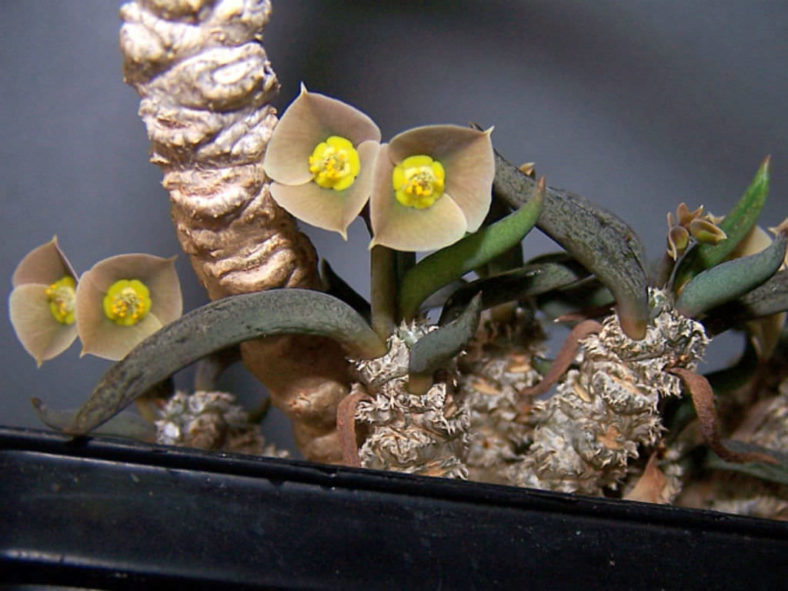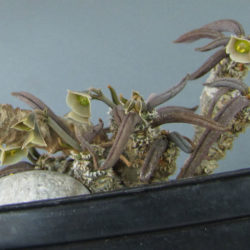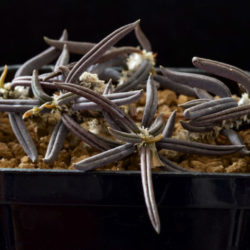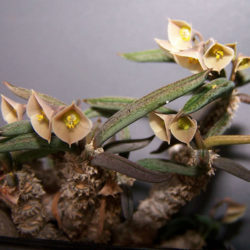Scientific Name
Euphorbia cylindrifolia Marn.-Lap. & Rauh
Synonym(s)
Euphorbia cylindrifolia subsp. cylindrifolia, Euphorbia cylindrifolia var. cylindrifolia
Scientific Classification
Family: Euphorbiaceae
Subfamily: Euphorbioideae
Tribe: Euphorbieae
Subtribe: Euphorbiinae
Genus: Euphorbia
Description
Euphorbia cylindrifolia is a small succulent with narrow, dark reddish-green leaves on numerous slender branches that arise from a swollen main stem. The caudex can grow up to 4 inches (10 cm) in diameter and is developed only the plant is grown from seed. The branches are erect, ascending, or decumbent and can reach up to 6 inches (15 cm) in length and 0.2 inches (0.5 cm) in diameter, twisting over each other and forming a hemispherical cushion. The leaves are fleshy, deeply channeled on the upper surface, and measure up to 1.2 inches (3 cm) long and 0.15 inches (0.3 cm) in diameter.
The cyathia (false flowers) are solitary or paired with yellow nectar glands surrounded by large, grey-violet to yellowish-pink, petal-like bracts. They appear on up to 1.2 inches (3 cm) long stalks at the end of the branches in summer.
Origin
This species is native to Madagascar. It grows in subtropical or tropical dry forests and subtropical or tropical dry shrubland.
Etymology
The specific epithet "cylindrifolia (sil-Iin-drih-FOH-lee-uh)" means "having cylindrical leaves" and refers to the leaves of the species that have a cylindrical shape.

Hardiness
USDA hardiness zone 10b to 11b: from 35 °F (+1.7 °C) to 50 °F (+10 °C).
How to Grow and Care
Euphorbias are very easy to care for. They require a little pampering to become established, but once they are, they are self-sufficient. In fact, more die from too much care and watering than from neglect. Euphorbias need well-draining soil and lots of sunlight. They are not particular about soil pH but cannot tolerate wet soil. Unlike most succulents, Euphorbia does not handle long periods of drought well. It may need weekly watering during the summer. Water whenever the soil is dry several inches below the surface. Water deeply, but don't let them sit in wet soil, which can cause root rot. Add some organic matter or fertilizer to the planting hole. Feed with a half-strength fertilizer monthly if you are growing them in containers or your soil is poor.
Euphorbia can be grown from seed, but they can be difficult to germinate (or even find). It is usually propagated by cuttings. This can be tricky because of the exuding sap. Rooting hormone is recommended with Euphorbias. They tend to grow problem-free, but there are a few pests and diseases to be alert for.
See more at How to Grow and Care for Euphorbia.
Links
- Back to genus Euphorbia
- Succupedia: Browse succulents by Scientific Name, Common Name, Genus, Family, USDA Hardiness Zone, Origin, or cacti by Genus


